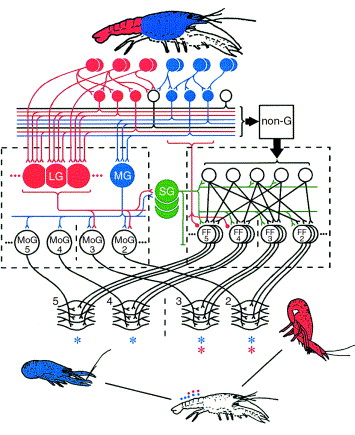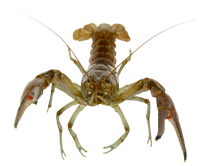Behavioral Neuroscience, lecture on Lateral Giant Neuron control of Crayfish Escape
Escape - Crayfish
VIII. Gating Lateral Giant Circuits
A. Sensory Interneurons (SI) have electrical synapses with LG neurons
1. bilateral sensory neurons both impinge on muliple SI
a. convergent inputs from 1o afferents broaden the signal
2. multiple SIs act on multple LGs
3. electrical synapses directly transfers depolarizing current (AP)
a. via gap junctions
i. connexons allow direct cytoplasmic contact
b. fast, unidirectional, highly reliable
4. SIs to LGs also inhibit some caudal FF motor neurons
B. LG neurons have electrical synapses with other LG neurons
1. LGs are a set of highly coupled neurons
a. 2/abdominal segment or 1/hemisegment
i. bilateral stimulation
b. giant axons in the dorsal nerve cord
2. bilateral LGs form a ladder-like network
a. functions like one neurons
i. with multiple input and output sites
3. BUT... LGs provide recurrent inhibition to limit firing
a. occurs at spike-initiating zone (SIZ)
i. where the LG projects meet the giant axon ladder
b. LGs release the inhibitory transmitter g-aminobutyric acid (GABA)
i. Bind GABAA receptors = Cl- channels
c. limit LGs to only one spike (or a few)
d. LGs inibit sensory and SI neurons input to LGs
e. LGs inhibt MoG output
i. feed-forward inhibition
f. \ strength and duration of escape behaivor is largely independent of simulus intensity
C. LGs innervate segmental giants (SGs) too
D. Like MG neurons, LG neurons have electrical synapses with MoG neurons
1. but not all of them  a. only MoG = motor Giants in the 1st through 3rd abdominal segments
i. motor neurons activating muscle in those rostral segments alone
b. latency of only a few milliseconds
2. trigger only a few rostral abdominal segments from caudal sensory stimulation
a. LGs produce a unique tail flip that drives the crayfish upward
E. LGs through electrical synapses activate Segmental Giant neurons (SG)
1. SG interneurons innervate all fast flexor (FF) motor neurons
2. but only rostral FF (1-3) fire
a. SI inhibition of FF 4-6 block contraction
i. GABA à GABAA on FF 4-6
F. Crayfish circuitry has 3 parallel circuits
1. but LGs uniquely gate the expression of upward thrust escape behavior
2. LG neurons directly activate a limited number of rostral MoGs
3. LGs active SGs à all FFs but...
i. LG-SIs inhibit caudal FFs
4. LGs (like MGs) stimulate a very strong response
i. but also limit that response through 4 kinds of GABA mediated inhibition
1) recurrent, sensory, SI, and MoG
a. only MoG = motor Giants in the 1st through 3rd abdominal segments
i. motor neurons activating muscle in those rostral segments alone
b. latency of only a few milliseconds
2. trigger only a few rostral abdominal segments from caudal sensory stimulation
a. LGs produce a unique tail flip that drives the crayfish upward
E. LGs through electrical synapses activate Segmental Giant neurons (SG)
1. SG interneurons innervate all fast flexor (FF) motor neurons
2. but only rostral FF (1-3) fire
a. SI inhibition of FF 4-6 block contraction
i. GABA à GABAA on FF 4-6
F. Crayfish circuitry has 3 parallel circuits
1. but LGs uniquely gate the expression of upward thrust escape behavior
2. LG neurons directly activate a limited number of rostral MoGs
3. LGs active SGs à all FFs but...
i. LG-SIs inhibit caudal FFs
4. LGs (like MGs) stimulate a very strong response
i. but also limit that response through 4 kinds of GABA mediated inhibition
1) recurrent, sensory, SI, and MoG

 a. only MoG = motor Giants in the 1st through 3rd abdominal segments
i. motor neurons activating muscle in those rostral segments alone
b. latency of only a few milliseconds
2. trigger only a few rostral abdominal segments from caudal sensory stimulation
a. LGs produce a unique tail flip that drives the crayfish upward
E. LGs through electrical synapses activate Segmental Giant neurons (SG)
1. SG interneurons innervate all fast flexor (FF) motor neurons
2. but only rostral FF (1-3) fire
a. SI inhibition of FF 4-6 block contraction
i. GABA à GABAA on FF 4-6
F. Crayfish circuitry has 3 parallel circuits
1. but LGs uniquely gate the expression of upward thrust escape behavior
2. LG neurons directly activate a limited number of rostral MoGs
3. LGs active SGs à all FFs but...
i. LG-SIs inhibit caudal FFs
4. LGs (like MGs) stimulate a very strong response
i. but also limit that response through 4 kinds of GABA mediated inhibition
1) recurrent, sensory, SI, and MoG
a. only MoG = motor Giants in the 1st through 3rd abdominal segments
i. motor neurons activating muscle in those rostral segments alone
b. latency of only a few milliseconds
2. trigger only a few rostral abdominal segments from caudal sensory stimulation
a. LGs produce a unique tail flip that drives the crayfish upward
E. LGs through electrical synapses activate Segmental Giant neurons (SG)
1. SG interneurons innervate all fast flexor (FF) motor neurons
2. but only rostral FF (1-3) fire
a. SI inhibition of FF 4-6 block contraction
i. GABA à GABAA on FF 4-6
F. Crayfish circuitry has 3 parallel circuits
1. but LGs uniquely gate the expression of upward thrust escape behavior
2. LG neurons directly activate a limited number of rostral MoGs
3. LGs active SGs à all FFs but...
i. LG-SIs inhibit caudal FFs
4. LGs (like MGs) stimulate a very strong response
i. but also limit that response through 4 kinds of GABA mediated inhibition
1) recurrent, sensory, SI, and MoG